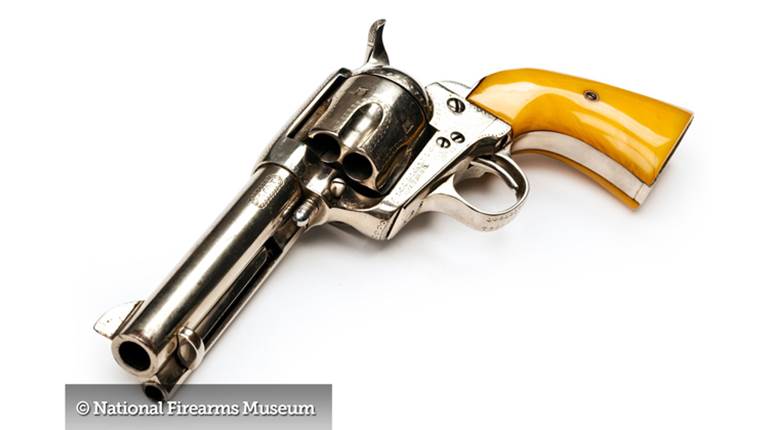
Originally printed in The American Rifleman, March 1927
By W. E. Fairbairn, Chief Instructor, Shanghai Police, Shanghai, China
If you are keen on winning silver cups, seeing your photograph in the papers as the pistol champion, or think that pistol shooting is only a sport, you had better not trouble to read this any further, because the method described will upset your "bullseye" shooting and prevent you from ever becoming a target champion. It is written for the man who is liable to be shot at and killed at any moment. For him it ceases to become a sport but is a matter of life and death.
We hear so much about the poor shooting of the police, how they do not know one end of the gun from the other, and how, if they would only take up serious instruction on the lines as laid down for the Army and Navy there would be a great improvement.
This being so (personally I doubt it), does it not seem strange that the percentage of expert target shots with the one-hand gun of the armies and navies of the world is less than 5 per cent? Yet it is their profession and the least one should expect from professionals is a much higher percentage of efficiency. This, on the face of it, looks as if something is wrong, and the question arises, is it the method of instruction, or the men?
Everyone knows that it is the ambition of every red-blooded man to be able to use the one-hand gun. That being so—and keen-ness to learn is recognized as half the battle— the trouble must be in the method of instruction.
From our experience of army, navy, and police methods of instruction, which extends over the past twenty-six years, we give it as our opinion that it is the method of instruction that is wrong, not the men. There is no reason in the world why any man of average intelligence cannot become a good and safe one-hand gun shot, providing he is keen, and with the automatic pistol taking the place of the pistol and revolver, the length of time accessary to bring a man to a high standard of efficiency is considerably reduced.
Our preference for the automatic pistol is briefly as follows:
Our experience, the result of years of instructing with both weapons, has clearly shown that it takes five times the amount of ammunition to make a man as proficient with the revolver, compared with the automatic pistol, also years of practice are required with the revolver, to get used to the "feel" of the gun. Whereas the automatic pistol fits the hand, and even the novice immediately gets the feeling of a sense of direction when handling it for the first time, which is far more than the old timers can say when they first took up shooting with the old .45 Single Action.
Revolver ammunition is not so reliable as automatic pistol ammunition, the percentage of miss-fires being approximately:Automatic pistol ammunition—1 per 10,000 rounds
Revolver ammunition—5 per 1,000 rounds. 
These figures refer to ammunition from reputable firms, not home-loaded cartridges. Further, although it may seem strange, revolver ammunition will not stand up to rough and careless handling to the extent that automatic pistol ammunition will.
We do not altogether condemn the revolver, and there are certain occasions when we would prefer to carry one in preference to the automatic pistol; such as when the gun must be carried concealed and the shooting done through the pocket or cloak; but when we are looking for our man, we want the automatic pistol on account of its greater rapidity of fire, well knowing that we can prevent the other man from firing a second shot, providing we both started off with an "even break."
To become a good automatic pistol shot, one must remember right at the start that the automatic pistol is, or should be, carried for quick work at very close range, under such conditions where it would be almost impossible to use a rifle of carbine. There will be no time to line up the backsight with the foresight, and if your shot takes longer than a third of a second in the "let off" you are not going to be the one to tell the newspapers about it. It is obvious that the foundation of practical automatic pistol shooting is speed, and more speed.
Always bear in mind that if your shot is a tenth of a second in advance of the other man he will not hit you with his shot, and there is always this certainty that your shot will upset your, opponent's accuracy in the event of its having missed.
Take the records of the New York and Chicago police and see if the average distance at which effective shooting has taken place, both at and by the police during the past five years—long, if you like—and we shall be surprised if it is over five feet (not yards). It does not take much power of imagination to see that at that distance it is a question of the greatest possible speed, and owing to the disconcerting knowledge of knowing that the other man is trying to kill you, your firing will have to be done instinctively, and the greater the volume of fire you can put in the greater the chance of your living.
We advocate in our method: Grip the pistol as if it was 30 or 40 pounds in weight. Try to imagine the target is an armed assailant who is shooting back at you. Cultivate the offensive spirit, and if your time is up—well, die fighting. When you can get that spirit into your shooting, you have some idea of what practical pistol shooting really is and the "wild and wooly West" stories you have read will appear more understandable.
When you read of pistol shooting at 20, 30, and 50 yards forget it. If your shooting is going to be at that range, start in right away with a high-power carbine with which you could get your man long before he would have time to draw his one-hand gun, without even having to raise the carbine from the hip. Records show that the number of hits made with the one-hand gun at ranges of 20 yards and over (under practical conditions such as previously described), are so few that they are not worth worrying about.
We do not expect the expert bullseye target shots to agree with us in this method, but we are of opinion it is far and away superior (for getting effective results) to any other method we have previously seen. All we ask is that they will give it a fair trial, after which they can come back to us for all they are worth. We shall be ready for them.
The man who unavoidably kills another with a loaded automatic pistol does not exist. "I thought it was not loaded" is the usual cry. It is, therefore, obvious that the first thing in instruction is safety precautions: The automatic pistol should be regarded as always loaded until the magazine has been removed and the slide worked—i.e., pulled back to its full extent several times; this will eject the cartridge from the breech, should one happen to be inserted.
When a jam occurs: Keep the pistol in the firing hand, barrel pointing towards the ground at an angle of 45 degrees from the body. Remove the magazine and work the slide. It is surprising how many men would, if not prevented, look down the barrel when a jam occurs.
When carrying a pistol, loaded or unloaded, it must be held at the "ready position": arm straight at an angle of 45 degrees from the body, pistol pointing towards the ground. This is the safest method of carrying a pistol, and it allows the weapon to be brought up to the firing position much quicker than is possible from any other position; further, the fact that one is armed is not widely advertised. The pistol is not intended for use as a signaling flag.
It is advisable that a little empty pistol practice should first of all be had so as to get the feel and balance of the pistol—care being taken to prove the pistol empty.
Ready Position—To find the correct position: Stand square with the object, feet apart, taking deliberate aim at the center of the object. When correct, lower the pistol, bring it down in a vertical line so that the pistol is in line with the center of the body. If the wrist has not been moved up or down, left or right, the correct position will be: Facing the target, arm straight, pistol a continuation of the right arm, with a slight twist of the wrist towards the right hand side. (Fig. 1.)
Variation in grip is a common error when firing with the automatic pistol, resulting in scattered shots. To overcome this, grip the pistol firmly as if it was 30 or 40 pounds in weight.
Note.—Attention is called to the fact that the only unnatural part of the Ready Position is the slight twist of the wrist towards the right-hand side. This twist of the wrist amounts to nothing more or less than the alignment of the sights, etc., by sense of feel, in a manner resembling that of the golfer when gripping the club before commencing the swing to drive.
Keeping both eyes focused on the center of the object, and taking care the right thumb is straight and parallel with the bottom of the slide, raise the pistol in a smooth upward movement from the shoulder (Vertical Lift), and when it cuts the line of sight, make a pause of a fraction of a second. (Figs. 1 and 2.) Fire the pistol by releasing the trigger with an equal pressure of fingers and thumb, then immediately release the trigger to allow the sear to re-engage and return to the Ready Position. (Fig. 3) 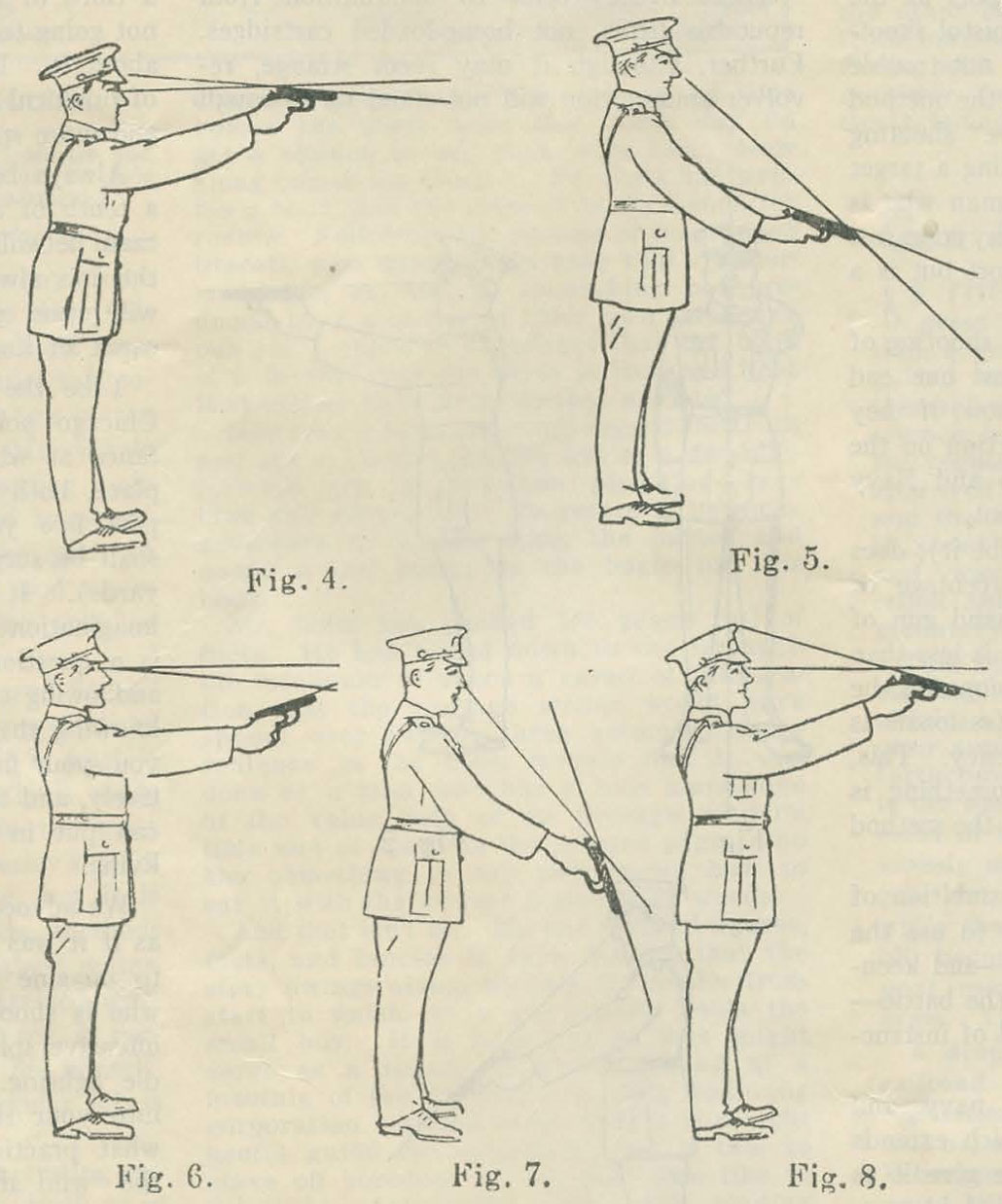
As previously stated, a shot that takes longer to fire than one-third of a second is wasted. It is, therefore, obvious that there is not sufficient time to align the sights, in addition to bringing the pistol up to the object. All men who make 100 per cent score at surprise targets fire with both eyes open, although in some cases they are unconscious of doing so. This is the only practical way of firing a pistol, as a trial will convince anyone that with both eyes open the master eye always takes charge.
By closing one eye, the field of view is restricted. This would be fatal if you were being attacked from an unknown quarter.
Note.—Attention is called to the vertical line on Fig. 1. It will be clearly seen that when you can consistently raise and lower your pistol with the muzzle cutting this imaginary line, that you will hit anything that is in front of you.
Also, the same rule applies for shooting in the dark: It only being necessary to remember that you must keep your body square and face your object.
Having gotten the feel of the muscles in the wrist and arm sol that you can consistently perform the "Vertical Lift" without having to watch your pistol, you have laid the foundation of practical pistol shooting and you are now ready to commence learning to gain time in loading.
To load, stand square with the target, holding the pistol in the right hand, back of the of the hand toward the ground, pistol at an angle of 45 degrees from the body, pointing toward the ground to the front, insert the magazine. Turn right hand over towards the left, back of the hands on top, seize the slide of the pistol with the left hand, thumb on top, keep a firm grip with the left hand and push the receiver away with the right hand (towards the ground.) When the receiver is right forward, release the grip with the left hand and allow the recoil spring to drive the top cartridge into the breech. Turn the right wrist to the right so that the slide is on top. You will then be in the position shown in Fig. 3.
Manufacturers of automatic pistols usually in their pamphlets tell you to "pull back the slide with the left hand." This is often very difficult, especially for some men, and we have found that it is much simpler to hold the slide with the left hand stationary, left arm bent, the elbow resting against the body, and push, the receiver away with the right hand. Seeing that the movement of the right hand is the initial start towards the Ready Position, we have gained time, and anything that will enable you to do that must not be neglected.
The above must be one continuous movement and should be practiced so that it can be performed in about a third of a second.
Firing Practice
First Practice (stationary man) Target:—Man-size target, withrectangles marked in the center as follows: 4-inch by 8-inch, 8-inch by 12-inch, 12-inch by 16-inch, with a 1-inch by 1 ½ -inch black mark in the center of the smallest rectangle, with a range of not more than 3 to 4 yards. Charge the magazine with four rounds and load. (Fig. 3.)
Keeping both eyes focused on the black spot, raise the pistol as quickly as possible (by the vertical lift) and immediately the pistol cuts the black spot, fire two rapid shots (as rapidly as your trigger finger can be made to work), make a pause (Fig. 2), see where your shots have hit, and then come down to the Ready Position. Neither in this or any of the following practices should you see your sights, the action should be far too quick for that.
Repeat and again fire two rapid shots and return to the Ready Position and unload. To do this, hold the pistol in the right hand, back of the hand towards the ground, barrel pointing downwards to the front at an angle of 45 degrees from the body, press on the magazine catch with the thumb and catch the magazine in the palm of the left hand.
Turn the right hand over towards the left, back of the hand on top, seize the slide with the left hand, and with a forward movement of the right hand work the slide to and fro. This will extract the cartridge, should one happen to be in the breech. When certain that the barrel is empty, press the trigger, keeping the pistol pointing towards the ground. If your shots are not in the center rectangle, a glance at the diagrams will give the reason. Correct your error and fire again.
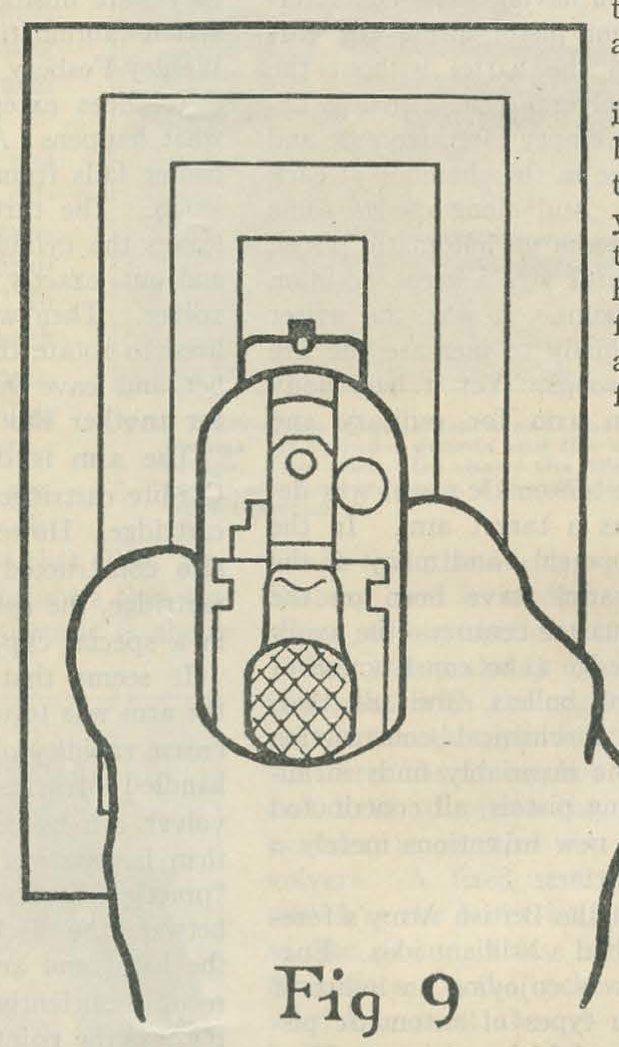
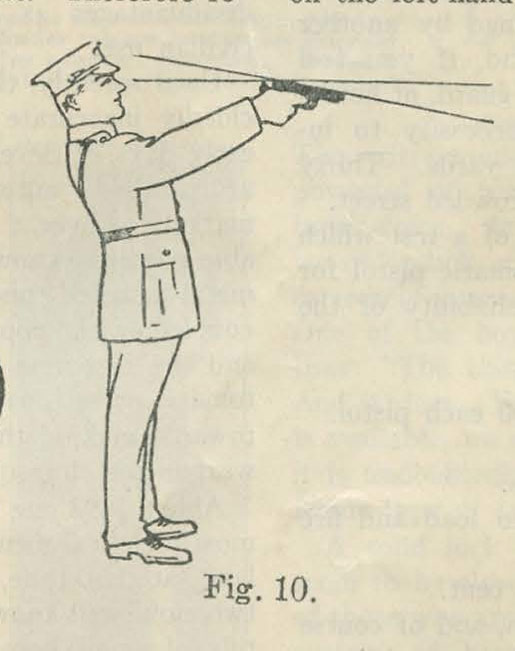
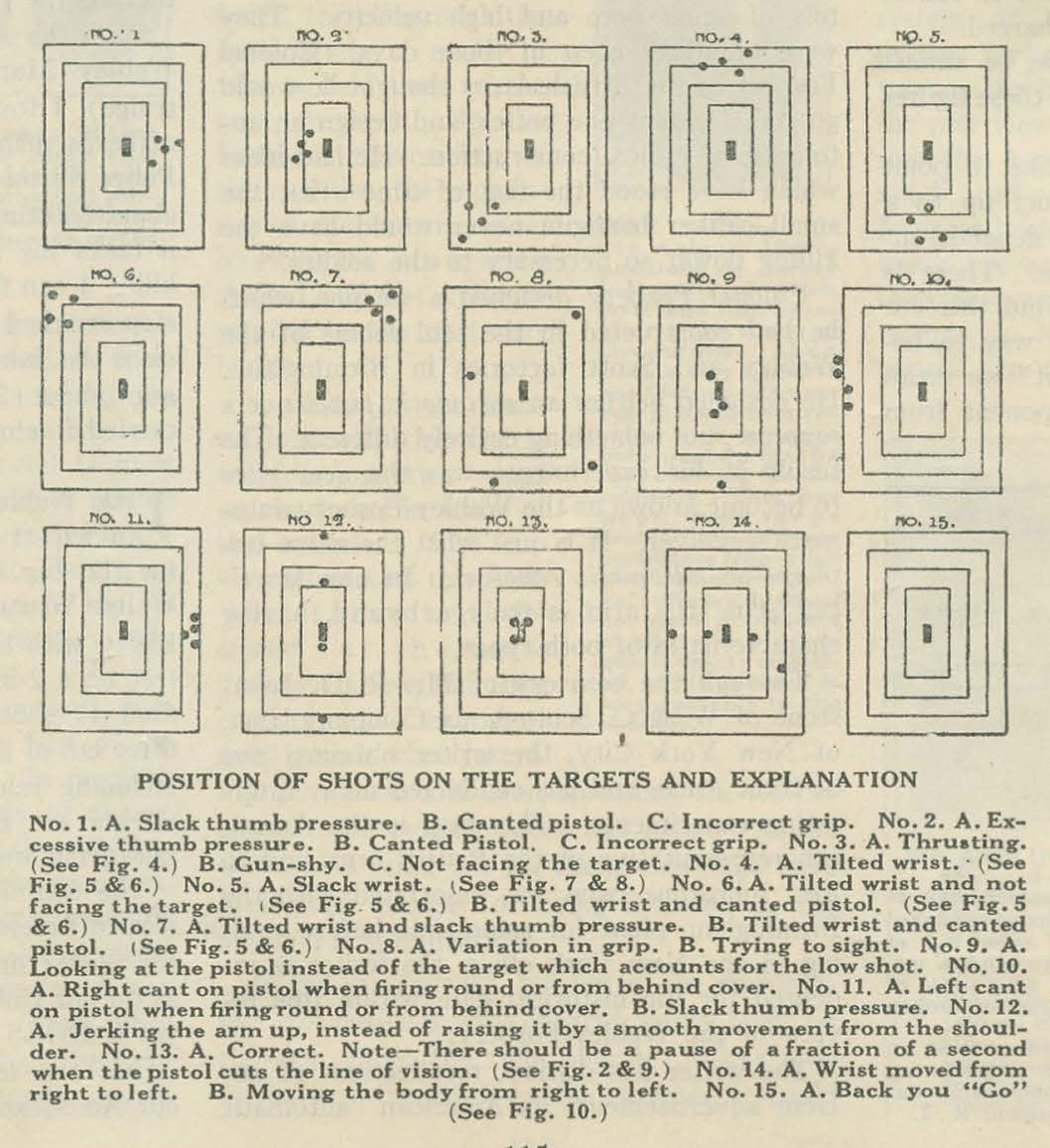 At this stage you will notice that wherever you are facing your shots will go. This is because there is not sufficient time to align the sights and should help to convince you that the most natural position for the body is square with the object.
At this stage you will notice that wherever you are facing your shots will go. This is because there is not sufficient time to align the sights and should help to convince you that the most natural position for the body is square with the object.
For those who find a difficulty in keeping square with the object, the following will be found to be of great help:
At the moment of raising the pistol by the Vertical Lift, advance the left foot, even to the extent of making a lunge. This lunge forward with the left foot will so help to cultivate the offensive spirit that is so necessary in practical pistol shooting.
Do not worry too much at this stage because one of your shots may have clean missed a man-size target. Always remember that a man hit in the region of the stomach will not fire back. If your shots have been fired as rapidly as possible, it is immaterial if it was the first or second shot that hit.
When you can consistently place one out of each string of two shots in the center or second rectangle (each string having been fired as quick as it is possible to count "one, two "), increase the range to 5 yards and refire.
Second Practice (Bobbing man): Man-size target, exposed up to the waistline, for one second 12-inch by 16-inch rectangle in the center; range not more than 5 yards. Charge the magazine with four rounds and load (Fig. 3).
Upon the target being fully exposed, raise the pistol as quickly as possible and fire two rapid shots, wait a pause and return to the ready position, then repeat.
When you can consistently place three out of four shots in the 12-inch by 16-inch rectangle, you have mastered this practice.
Third Practice (running-man practice). (Run of 10 to 12 feet and 3 to 4 miles per hour.) Target, man-size; range not more than 5 yards. Charge the magazine with four rounds and load (Fig. 3).
When the target is fully exposed, fire, two rapid shots as in previous practice. So as to enable you to keep your body square with the target, do not move the feet, but swing the hips, in a like manner to a clay-pigeon shot, firing at a right and left rise.
Try and remember that your shot will reach the target in approximately a fiftieth part of a second. Therefore, there is no necessity to make any allowance and aim ahead.
For every shot that is fired and missed behind at this practice (running man), you can be sure there are 90 that have missed in front, in some cases as much as three feet. Therefore focus your attention on the part of the object you wish to hit and you will be surprised to find out how much truth there is in the saying, "You hit where you look," in the same manner as when throwing a stone or a ball.
One hit out of each string of two shots is good enough—you have got your man.
Fourth Practice (rapid loading and firing). Target, man-size. (Running man, as in No. 4). Range, 3 to 5 yards.
Pistol drawn and magazine loaded with two rounds, and inserted in pistol with left hand on the slide, ready to load.
Upon the target appearing, load and fire two rapid shots. Then unload.
When you can consistently hit this target twice, the practice should be repeated, with this addition: the magazine charged with two rounds and pistol in the holster. Upon the target appearing, draw, load, and fire the two rounds. We advocate wearing the holster on the left-hand side of the belt, in front of the left arm.
The pistol is or should be, carried empty, with the magazine charged and properly inserted. From this position we have drawn, loaded, and fired, and hit in approximately one second. Those of you who have other ideas of where the holster should be worn may be converted to our way after giving it a trial. That is, you who, like the writer, carry your guns outside a uniform.
You will have noticed that we have a very poor opinion of any of the so-called safety catches, etc. On our own private guns, all of these are pinned down so that they cannot function.
Do not trust any "safety catch," or in fact anyone except yourself. You would not ever think of handing your friend a loaded shotgun by the barrel end, just because the safety lock was on, for the simple reason you, in the back of your mind, do not trust it. In a like manner cultivate a good habit in handling the automatic pistol. There is only one safety device, and that is best explained in the following lines:
When unloaded you THINK you be,
Please DON’T POINT your gun at me.
That it may UNLOADED be
Matters not a d—to me.













